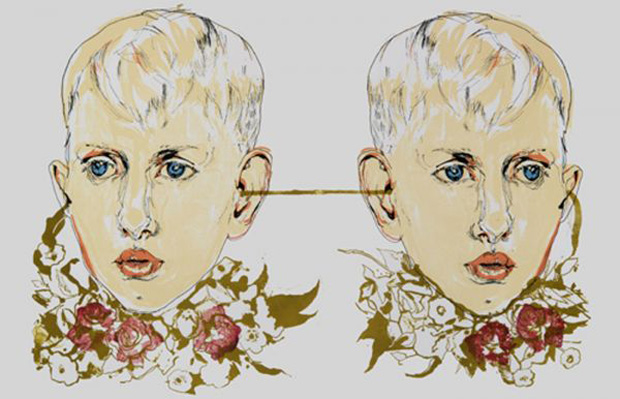Art that’s not for the faint of heart
Published February 6, 2013
When you walk into Gallery 210 at UMSL to see Laced, artist Peregrine Honig’s first solo show in St. Louis, you might be shocked, disgusted, confused, or intrigued. Honig’s work is not for the faint of heart. She tackles all manner of themes: pop culture, gender, sexuality, and crimes against humanity, including the Holocaust and Argentina’s Dirty War; and she does a fine job. Spend a little time with her art and she’ll win you over.
The title of the show refers in part to lace collars worn by early modern Europeans in the sixteenth and seventeenth centuries. Honig references the collar in a piece layered with meaning called Propaganda, which comprises nine nearly identical prints of two blond boys facing away from each other, wearing circlets of flowers around their necks, and connected by a green cord running through their ears.
You’ll see the blond boy in a number of Honig’s pieces. He may represent a generic fairy tale character or saint. In Propaganda, he embodies both masculinity and femininity because of his flower collar. The flowers are also inspired by Honig’s time in Argentina, whose culture decorates three-dimensional life-size figures of saints with clothing, flowers, and even human hair. Honig compares her piece to posters for a rock concert because of its multiples, which make it seem less precious. It becomes like ephemera. In fact, the brochure for the show has an image of the boys on the back and could be a poster in its own right.
The thread connecting the boys may represent something audible like a song, or something physical growing between them. Honig is interested in imagery that has a lot of different meanings.
One set of these meanings concerns Propaganda’s historical strata, from the flowered Elizabethan ruff to the boys’ resemblance to Macauley Culkin in Home Alone. The blond, blue-eyed boys also reference Nazism and the ties between Argentina and the Nazis.
The artist explores another horrific period in history with her images of animals nursing human babies and human mothers nursing young animals. This biological perversion references Argentina’s Dirty War, government-sanctioned acts of terrorism in the late 1970s against Argentines suspected of acting against the ruling dictatorship. Tens of thousands of people “disappeared” (were placed in detention camps) during this time. Babies born to imprisoned mothers were given to military families to raise after their birth mothers were killed. In the 1990s the government initiated DNA testing and informed the now-grown children if they were adopted. Thus the children had to come to terms with what happened to their biological parents.
Honig explains that when the children learned of their own true identity, they saw their adoptive parents as monsters. Her work is a metaphor for this. She drew the animal images in a rough style because she imagines the perverted “families” existing in the wild, somewhere awful and primal.
And if you’re a fan of reality TV, you’ll remember that Honig participated in the reality show Work of Art: The Next Great Artist on Bravo in 2010.
Laced is on view through March 23 at Gallery 210, between the police station and the Touhill Performing Arts Center. Gallery hours are Tuesday – Saturday, 11:00am – 5:00pm; and closed Sundays and Mondays. For more information, call 314-516-5976 or visit http://gallery210.umsl.edu.














